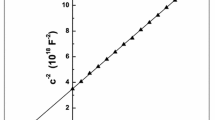Abstract
Heterojunction solar cells (HJSC’s), fabricated by electron beam evaportaion of SnO2 films onto monocrystalline and polycrystalline Si substrates, show conversion efficiencies as high as 9.9%, fill factors of 0.64, and open circuit voltages of 525 mV under AMI simulated irradiation. The SnO2, an n-type semiconductor, acts as a transparent window to solar irradiation and as an antireflection coating of the Si, and it provides the band bending in the Si necessary for photovoltaic conversion. The SnO2 films, nominally 50 nm thick, have conductivities of the order of 103(Ω-cm)−1 so that the film makes a good electrical contact between the junction and the metallic front contacts. Measurements of C−2-V and I-V characteristics are consistent with heterojunction theory, and the data imply an electron affinity of the SnO2 of approximately 0.8 eV greater than the electron affinity of Si. This value limits the open circuit voltage of HJSC’s made on p-type substrates to values too small for useful photovoltaic conversion. The predominant dark current mechanism of units of n-type substrates at room temperature and forward bias in the range of 0.3−0.5 V is electron-hole recombination in the transition region. The experimentally determined activation energy is 0.51 eV, approximately Eg/2. At forward voltages below 0.3 V, multistep tunneling via interband states predominates. The photocurrent apparently depends on interface states through which the photogenerated holes in the Si recombine with electrons in the SnO2.
Similar content being viewed by others
References
E. Giani and R. Kelly, J. Electrochem. Soc.,121, 394, 1974.
T. Nishino and Y. Hamakawa, Jap. J. Appl. Phys.,9, 1085 (1970).
J. Kane, J. Electrochem. Soc,122, 1144 (1975).
Z.M. Jarzebski,Oxide Semiconductors (Pergamon Press Ltd., Oxford, 1973) Chap. 15, p. 252.
E.E. Kohnke, J. Phys. Chem. Solids,23, 1557 (1962).
M. Nagasawa et al, Jap. J. Appl. Phys.,4, 195 (1965).
T. Arai, J. Phys. Soc. Japan,15, 916 (1960).
K. Ishiguro, T. Sasaki, T. Arai and I. Imais, J. Phys. Soc. Japan,13 296 (1958).
F. Kajiyama and Y. Furukawa, Jap. J. Appl. Phys.,5, 905–906 (1967).
R. Williams, RCA Rev.,30, 306 (1969)
R.L- Anderson, Appl. Phys. Lett.,27, 691 (1975).
Author information
Authors and Affiliations
Rights and permissions
About this article
Cite this article
Franz, S., Kent, G. & Anderson, R.L. Heterojunction solar cells of SnO2/Si. J. Electron. Mater. 6, 107–123 (1977). https://doi.org/10.1007/BF02660378
Received:
Issue Date:
DOI: https://doi.org/10.1007/BF02660378




